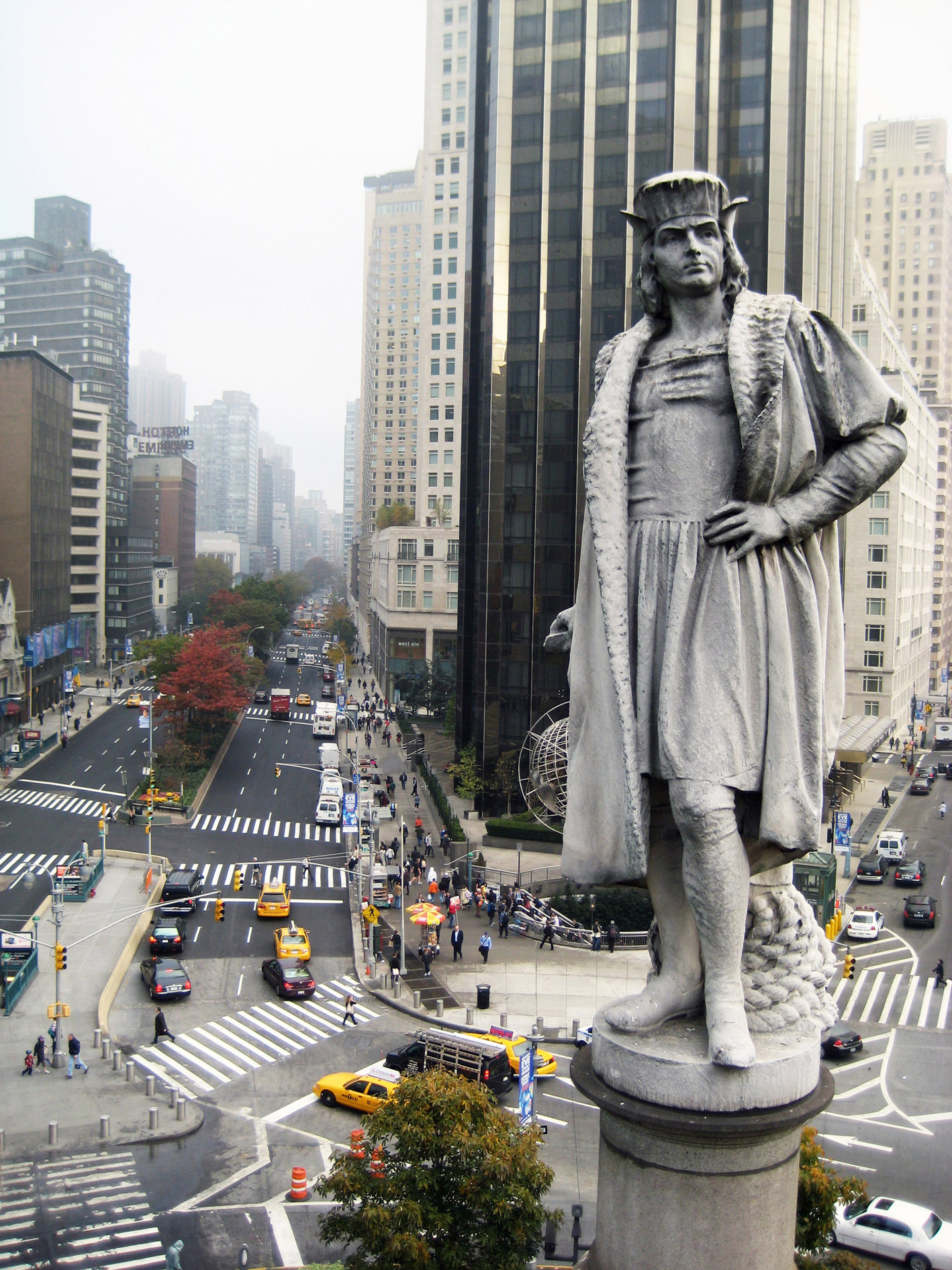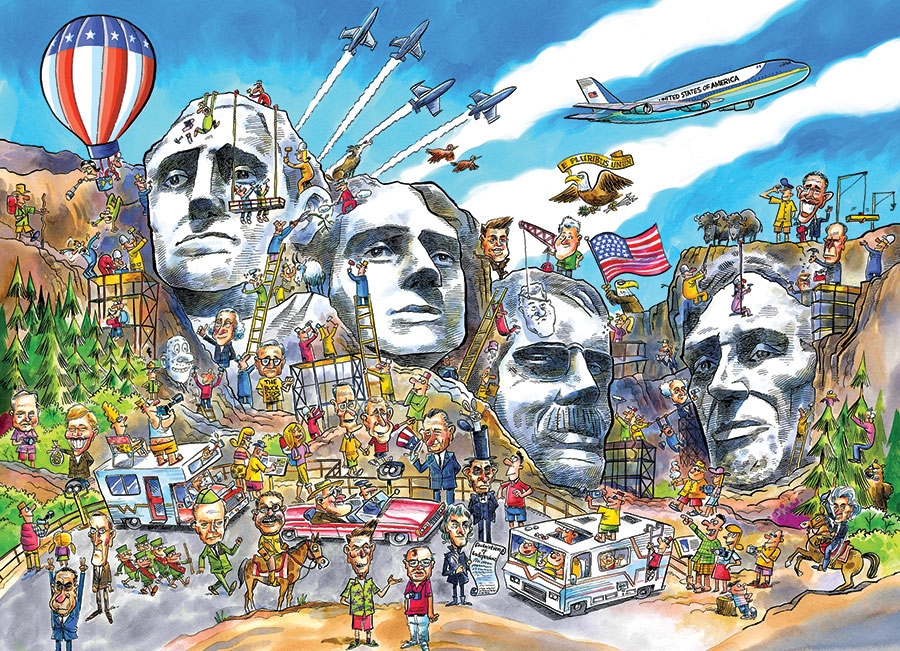Were They Great? Controversial American Monuments
Statue in Columbus Circle
Back in a fall blog, BOB director Michael Osinski addressed how “great”, while being integral to Bob’s quest, is an incredibly loaded word right now. That’s of course largely because of President Trump’s infinitely chanted, parodied, criticized, red hat-sewn slogan “Make America Great Again.” Critics of the mantra see it as an unwarranted romanticization of the America of days past; after all, what “greatness” does it refer to? On an issue-to-issue level, sure, it hearkens back to days many supporters yearn for, such as greater financial stability, or military strength. But taken at face value, it seems to glorify a country’s history throughout which there’s often not much to be proud of.
Lately, nothing seems to represent this confrontation of a shameful past better than statues and monuments -- physical relics that attract controversy for either deifying immoral figures, or for being erected under regrettable circumstances.
Vandalized statue of Columbus in San Diego
Christopher Columbus statues
When I was in middle school and learned about Christopher Columbus, he was touted as a visionary explorer and adventurer...and not much else. Not, for instance, a violent colonialist. A statue of him proudly stands in the center of Manhattan’s Columbus Circle. Why keep it up? Well, it was certainly intended to honor his exploratory accomplishments and faux “discovery” of North America...but it also inherently celebrates a man behind atrocities against indigenous peoples.
The circle does not contain the only statue of him; many have been targets of vandalism for years. After the events in Charlottesville in August 2017, a Columbus statue in Central Park had its hands painted blood red. A different bust of him in Yonkers, New York was fully decapitated around the same time. And just last week, a statue in Chula Vista Park in San Diego was spray painted, its base reading “GENOCIDE.”
Confederate monuments
A shocking number of monuments to figures of the Confederacy still stand across the U.S., from over 150 in Georgia, to some as northern as Washington State, where the Lake View Cemetery in Seattle houses a United Confederate Veterans memorial made of granite from Stone Mountain, a sacred site for members of the KKK. Stone Mountain, of course, also displays one of the most notable Confederate monuments: a massive relief of Jefferson Davis, Robert E. Lee, and Stonewall Jackson carved by Gutzon Borglum, who is most known for Mount Rushmore. Confederate monuments have been the target of countless protests and vandalisms, which recently gained national attention after the Charlottesville riots, one of the goals of the white nationalist protesters being to stop the removal of a statue of Lee.
The majority of arguments against the removal of Confederate statues involve the phrase “preserving history.” In response to this, after Charlottesville, the American Historical Association released an official statement, saying
“Understanding the specific historical context of Confederate monuments in America is imperative to informed public debate...The bulk of the monument building took place not in the immediate aftermath of the Civil War but from the close of the 19th century into the second decade of the 20th. Commemorating not just the Confederacy but also the ‘Redemption’ of the South after Reconstruction, this enterprise was part and parcel of the initiation of legally mandated segregation and widespread disenfranchisement across the South. Memorials to the Confederacy were intended, in part, to obscure the terrorism required to overthrow Reconstruction, and to intimidate African Americans politically and isolate them from the mainstream of public life.”
Charlottesville’s Robert E. Lee statue
A famous photograph of white nationalist protestors in Charlottesville
They ultimately recommend revisiting the place that statues and other monuments have, suggesting they not be destroyed but rather preserved in museums with apt context.
Crazy Horse Memorial
Unfinished Crazy Horse memorial
On a purely superficial level, a memorial to Crazy Horse, the Sioux leader who fought against white American imperialism, may seem like a worthy gesture to acknowledge bloody wrongs of the past -- especially if the monument was suggested by an actual Sioux chief. Unfortunately, sculptor Korczak Ziolkowski decided to do his sculpting, which began in 1948, in the Black Hills -- culturally significant Native American land now being desecrated (once again) by white hands. A living descendent of Crazy Horse’s family condemned it, saying,
“They don't respect our culture because we didn't give permission for someone to carve the sacred Black Hills where our burial grounds are. They were there for us to enjoy and they were there for us to pray. But it wasn't meant to be carved into images, which is very wrong for all of us. The more I think about it, the more it's a desecration of our Indian culture. Not just Crazy Horse, but all of us.”
The hypocrisy (as well as the probable physical accuracy of the rendering given that there are believed to be no existing photographs of Crazy Horse) is the subject of major controversy. As of now, the memorial is actually still unfinished -- largely due to lack of funding. Time will tell if it’s ever completed -- and what the reaction will be.
Mount Rushmore
When my family and I embarked on one of our cross country trips when I was in middle school, Mount Rushmore was probably the site I was most thrilled to witness. And that’s why I end on Mount Rushmore -- because it’s an icon. It’s a larger-than-life, instantly recognizable symbol of American greatness, attracting millions of tourists every year. But of course, it is still the subject of a hodgepodge of controversies, all compiled into one imposing mountain: it depicts two men who owned slaves. It depicts an imperialist. It is carved into the sacred Black Hills, by, as already mentioned, Gutzon Borglum, a member of the KKK. The layers of shame in American history are so deep, intertwined, and daunting, that it’s no wonder even this iconic site is bloodied by them.
Art by Cobble Hill Puzzle Company
If Mount Rushmore is an American wonder, what does that say about America?
All of these statues, monuments, and memorials are not going down overnight. Legal scuffles, protests, riots, and academic debate about their place in society will continue for the foreseeable future. It’s a battle that forces us to come face to face with just how great America never was, and how we want to represent that history as a country. In their Charlottesville statement, the American Historical Association wrote, “To remove such monuments is neither to ‘change’ history nor ‘erase’ it. What changes with such removals is what American communities decide is worthy of civic honor.”
What are your thoughts on the controversy around these memorials? What, in this day and age, can we count on the word “great” to really mean?
- Lucas






